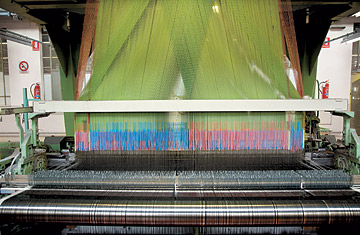
Weaving at Zegna's Trivero mill.
The descendants of Italian textiles entrepreneur Ermenegildo Zegna run the $1.27 billion family group—including the family wool mill their grandfather took over in 1910 and the men's luxury ready-to-wear label created in the 1960s—from a range of posts. But whether it's chief executive Gildo Zegna discussing emerging-market strategies at Zegna's sleek new headquarters in Milan, or Gildo's cousin Laura Zegna explaining the family's environmental-conservation projects on the mountain above the mill in Trivero, Italy, or his sister Anna Zegna pulling down giant handwritten ledgers in the company's archives nearby, the smell of the mill always comes up.
Past the grand entrance, worthy of a statehouse, and halfway down the stairs to the factory floor, the intoxicating, vaguely animal odor suddenly leaves visitors gasping for breath. The smell is not unpleasant, like the much stronger, more humid and astringent air of the dyeing rooms at one end of the main corridor. Here it's the sensation of dryness that's surprising, the feeling that one's mouth and nose are stuffed with cloth and sand.
"We were jumping in the wool as children. This family business was our lifestyle," explains Anna, Zegna's director of image and store development, as she walks the grounds of the mill, pointing out a rooftop promenade where she and her cousins skated and learned to ride bikes, and the villa where they lived until they were well into elementary school. (Today the villa houses the company's archives, and the promenade has recently been lined with flapping flags, an installation by French artist Daniel Buren.) "After 50 years of smelling certain smells and touching the fibers, I think we have a holistic feeling for what we're wearing. You know, we're terrible—the whole family," she says, laughing. "We're at a party and always touching the jackets, rubbing up against the guests."
Ermenegildo Zegna's start was ordinary. His family, like many others in the Biella Alps region between Milan and Turin, had a small wool concern. The soft water in the area was ideal for washing wool. After founding his company in 1910, Zegna developed it over the next two decades by adopting an innovative approach. He went to England and invested in the best technology, then imported the machines and looms to Italy. He chose to specialize in high-quality wool fabrics and was energetic about finding the best sources and pushing breeders in Australia and New Zealand to improve their wool. He also invited ranch owners to Italy to see the manufacturing process up close so they could better understand the company's demands. He was searching for longer, stronger fibers that could be turned into long-wearing fabrics, which would become finer as technology improved—and the quest continues today.
In a business in which Italian manufacturers considered themselves middlemen, faithfully and quietly supplying tailors who sometimes became well known to the public, Zegna wove his name into the selvage of his fabric bolts for the end user to notice. Later, in the 1930s, in a surprising move for a wholesaler, he launched a consumer advertising campaign featuring a series of signs along Italy's railways that linked his name and the message of high quality in travelers' minds. During World War II, when wool-fiber imports were interrupted, Italian tailors regularly remade clients' suits, taking them apart and repiecing them so they could be turned inside out to look new, and Zegna's quality stood out, says Anna.
Zegna was determined to expand through exports, and in the 1930s he traveled to the U.S. to sell his goods directly to the best American tailors. After some hesitation about the cost, he threw a banquet in New York City for the top tailors. "He wrote to his wife, 'It's a big investment, $100, but I think it's worth it,'" says Anna. Today the nature of the business has changed, but the U.S. is Zegna's largest market.
The grandchildren remember their visionary grandfather as a gentle, somewhat remote man who liked to have them read him the newspaper, but their memories are sketchy. "I 'discovered' him in the archives," says Anna. She pulls down years of giant ledgers, in which he recorded in impeccably elegant longhand the details of orders. There are also books and boxes of samples of every fabric the mill ever produced—and he cataloged them in duplicate, with a complete set kept at his house above the mill in case one was lost in a fire.
It's interesting to contrast that maniacally orderly, disciplined approach to business and record-keeping with the imagination required for Zegna's craziest scheme: the reforestation of the bald mountain behind the mill. In addition to building a community center, school and clinic for Trivero's residents (1,200 of whom were employed in his mill), Zegna ordered and planted 500,000 evergreens and rhododendrons on the mountain and built a scenic road to the top. "His idea was that the quality of his product could not be developed unless the people also lived and understood the same values," says Anna.
Laura Zegna oversees the 24,710-acre (10,000 hectare) estate called Oasi Zegna on behalf of the family. Ten kilometers of scenic road were donated to regional authorities, but the family foundation maintains the land and develops controlled tourism, including new eco-sports, in the reserve. Currently there is a project to thin the original trees by 2020. In its largest stores, the company makes references to the founder's conservation philosophy. In the Milan flagship, shoppers climbing the stairs from the ground floor can view a lenticular photographic mural that rises two stories and shows the seasons changing at Oasi Zegna.